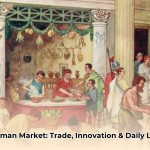Ever wonder how we decipher the intricate daily lives and expansive reach of the ancient Romans? While grand narratives of emperors and epic battles fill history books, much of our practical understanding of their society – from dietary habits to intricate trade networks and even prevailing fashion – comes from an often-overlooked source: humble pottery fragments. These ancient pots and plates are far more than mere utilitarian objects; they are invaluable time capsules, each shard revealing a facet of a civilization that shaped the Western world. Learn more about these Roman artifacts.
This article delves into the captivating realm of Roman ceramics, exploring their sophisticated production, far-reaching distribution, and profound impact on Roman society. We will examine the diverse uses of this pottery, uncover how cutting-edge technology is revolutionizing our knowledge, and understand how modern museums can transform these ancient artifacts into compelling narratives for contemporary audiences. Think of it as peeling back layers of history, one meticulously analyzed piece of clay at a time.
The Enduring Legacy of Roman Clay
Ancient Roman ceramics, though often celebrated for their practicality rather than the elaborate artistic flair seen in Greek vase painting, offer an unparalleled window into the intricate daily lives, expansive trade systems, and evolving cultural priorities of the Roman Empire. These seemingly modest items – ranging from simple cooking pots and elegant tableware to colossal transport containers – collectively illuminate a sophisticated social and economic framework. Each fragment of pottery can be envisioned as a piece of a larger historical narrative, collectively clarifying aspects of eating customs, religious rituals, and the precise mechanics of the Roman economy, revealing astonishing details about their chronology, commerce, and nuanced cultural traits.
The Dawn of Industrial Production and Regional Identity
A compelling aspect of studying Roman ceramics is the sheer volume discovered across the empire. This abundance underscores the remarkable efficiency of Roman mass production, which catered to both everyday necessities and more formal occasions. Simple, coarse wares fulfilled the basic demands of daily life for all social classes, while more refined, decorative pieces subtly conveyed social standing and cultural adherence.
Despite this extensive system of standardization and mass production, distinct regions often cultivated their own unique pottery styles. Local artistic preferences, specific manufacturing techniques, and regional demands all contributed to the rich diversity of Roman ceramics across the vast imperial domain. For instance, while Italy’s Arretine ware set initial trends, Gaul became renowned for its Samian ware (a type of terra sigillata) and Britannia for its distinctive Black-Burnished ware, each possessing its own ceramic signature. Workshops in North Africa later dominated markets with African Red Slip ware, further diversifying the ceramic landscape.
Amphorae: The Arteries of Empire
Consider the Roman Empire as a living organism, with amphorae serving as the vital conduits circulating its commercial lifeblood. These iconic, two-handled clay containers were indispensable for long-distance commodity transport. Essential goods like olive oil (as evidenced by Monte Testaccio, the colossal artificial hill in Rome made almost entirely of discarded amphorae), wine, and the highly popular fermented fish sauce known as garum traversed the empire within these sturdy ceramic vessels. Their frequent appearance in archaeological excavations and shipwreck sites, such as the Madrague de Giens wreck with over 6,000 amphorae, allows experts to meticulously chart ancient trade routes and comprehend the sheer scale of Roman commerce.
The sheer volume of amphorae employed was staggering, truly forming the backbone of the entire distribution network. Without these durable vessels, the extensive commercial exchange that characterized the Roman world, from the late Republican period until the late Empire, would have been drastically curtailed. Early classifications by scholars like Heinrich Dressel (e.g., Dressel 1, Dressel 2-4) remain fundamental, enabling archaeologists to pinpoint origins and date archaeological layers with remarkable precision.
Terra Sigillata: Pottery as a Cultural Emblem
Among the many varieties of Roman ceramics, Terra Sigillata holds a particularly prominent place. Also recognized as Arretine ware (and later Samian ware in Gaul), this exquisite pottery, distinguished by its gleaming red slip surface and often intricate relief decoration, was a highly coveted commodity across the empire. It served as both a marker of high status and a powerful vehicle for the dissemination of Roman culture.
While owning Terra Sigillata might simply have signified wealth, its widespread adoption also represented a deeper allegiance to Roman identity and values, thereby illustrating one’s integration into the empire. Scholars propose that possessing such items not only showcased affluence but also a degree of “Romanization,” particularly in newly conquered provinces. The technique of making relief decoration through molds, often using individual stamps (poinçons) and later copying prestigious metalwork, allowed for standardized, yet aesthetically pleasing, products.
Art, Utility, and Resourcefulness: A Roman Synthesis
An ongoing scholarly debate concerns the artistic merit of Roman ceramics. Was functionality the primary Roman concern for their pottery, or did they also appreciate its aesthetic qualities? Some scholars suggest that, when compared to the Greeks and Etruscans, Romans placed less emphasis on elaborate, ornate painted pottery. However, the complex molded patterns, lustrous finishes, and the widespread use of lead glazes found on certain pieces strongly imply a significant level of artistry. This suggests that Roman ceramics transcended mere utility, holding considerable cultural significance and aesthetic appeal alongside their practical uses. The inherent variety and quality of these artifacts demand a more nuanced interpretation, showcasing a sophisticated synthesis of form and function.
The Romans were remarkably resourceful, reflecting an early understanding of material value. Broken pottery was rarely simply discarded; it was frequently repurposed or recycled. For instance, crushed pottery, known as testa, was incorporated into concrete and mortar, creating stronger, more durable building materials. Large fragments were used as lids, improvised plates, or even as building fill in urban development, contributing to the formation of structures and roadways. Amphorae, after their primary use, were often repurposed for domestic storage, cut in half to serve as planters or even primitive toilets, or used as burial containers for infants. This commitment to practicality and waste management is powerfully illustrated by sites like Monte Testaccio, standing as a potent reminder of ingenious ancient resource management.
Decoding Daily Life and Economy Through Potsherds
Roman pottery, far from being inert relics, offers a compelling window into the functional mechanics of the Roman Empire. These ubiquitous objects provide unique insights into their economy, social structures, and customary habits. While often perceived as mere containers, Romans employed pottery for a vast array of purposes, including cooking, dining, storage, lighting, and even architectural elements.
Unearthing Clues: What Shards Tell Us
Pottery shards are not mere refuse; they are invaluable tools for dating archaeological sites with remarkable precision. Distinct pottery styles and manufacturing techniques evolved significantly over time, enabling archaeologists to accurately date diverse sites and historical events, much like tracking shifting fashion trends. Furthermore, the presence of potters’ marks—such as names (e.g., Fortis, Atimetus) or workshop stamps (figlinae)—provides crucial data for tracing ancient trade routes and identifying specific production locations like La Graufesenque, whose products reached India and Scotland. Tituli picti, painted inscriptions on amphorae, provided information on contents, weight, and commercialization.
Mortaria, the robust, gritty grinding bowls, offer direct insight into culinary practices and the broader processes of Romanization. Their widespread use across the empire indicates the adoption of Roman cuisine, which relied heavily on pureed or pulverized ingredients like herbs, spices, nuts, vegetables, and even meat. By meticulously examining these fragments and their markings, archaeologists skillfully piece together a comprehensive picture of Roman daily existence and economic activity.
The Breadth of Roman Ceramic Use
Roman kitchens relied heavily on ceramic vessels for food preparation and consumption. Cooking pots, known as ollae, were used for boiling and stewing, while caccabi and patellae represented other common cooking vessels. Tableware, including patinae (plates), catini (bowls), and calices (cups), varied greatly in quality from plain coarse wares used by the poor to high-quality Samian ware for elite dining.
Beyond the kitchen, amphorae and large dolia were used for long-term storage and transportation of goods like wine, olive oil, and grain. Ceramic oil lamps were essential for lighting homes and public spaces, often featuring decorative motifs ranging from mythological scenes to gladiatorial combat. Terracotta figurines were made for ritual or religious purposes, as votive offerings, or as household shrine decorations, often painted in bright colors.
Fired clay also played a crucial role in Roman architecture. Structural bricks (lateres) and roof tiles (tegulae and imbrices) were standard building materials. Ceramic pipes were used for water and drainage, and the hypocaust heating system relied on terracotta elements like pilae (pillars of bricks) and interlocking box-tiles for flues in walls to circulate heat. Decorative elements such as antefixes (ornamental roof tiles) and Campana reliefs (figurative panels) further showcase the versatility of fired clay.
Preserving the Past: Museum Exhibits and Conservation
Ancient pottery transcends its status as mere broken fragments; it acts as a veritable time capsule, offering tangible connections to the very fabric of Roman civilization. It reveals astonishing details about their chronology, commerce, daily routines, and nuanced cultural traits. Furthermore, the ethical preservation of these objects is not just important; it is an imperative for future generations.
Pottery as a Chronological Compass
Distinct pottery styles evolved significantly over time, enabling archaeologists to accurately date diverse sites and historical events. This process is akin to tracking shifting fashion trends, but applied to plates and pots. Moreover, advanced scientific techniques, such as thermoluminescence dating and petrographic analysis (to determine clay sources), can be employed to establish impressively precise timelines and pinpoint origins. Classification systems like Dragendorff’s for red-gloss pottery or Hayes’ numbers for African Red Slip forms provide standardized frameworks for identifying and dating finds.
Mapping Ancient Networks
The discovery of specific pottery shards across disparate geographical locations provides compelling evidence for the exchange of goods and cultural practices between regions. For instance, encountering African Red Slip ware as far afield as Britain in the 5th-6th centuries, or Rhodian wine amphorae across the empire, reveals substantial insights into ancient trade routes and spheres of influence, allowing scholars to reconstruct complex commercial networks. The annona system, which supplied the army and the city of Rome, was a major driver of large-scale pottery distribution.
A Glimpse into Roman Households and Minds
Have you ever wondered about the typical Roman diet or their modes of worship? A close examination of their cooking vessels, storage jars, and even ceremonial pieces offers profound answers, providing an intimate glimpse into their dietary habits, household routines, and spiritual beliefs. The decorative elements themselves are often highly informative, depicting myths, significant events (like gladiatorial combat on lamps), or prevailing artistic sensibilities. Inscriptions, from simple maker’s marks to ownership declarations (“Quintus owns this cup”), or even personal graffiti and religious dedications (e.g., “To Jupiter Optimus Maximus”), offer rare glimpses into the thoughts and daily lives of ordinary Roman people, complementing more formal historical sources.
Fueling the Imperial Marketplace
These prolific pottery industries profoundly influenced the Roman economy, stimulating local production, generating employment opportunities for skilled artisans and traders, and contributing significantly to tax revenues through customs duties. From bustling urban centers like Pompeii and Ostia to the submerged remains of ancient shipwrecks, the archaeological record provides a vivid tableau of pottery manufacturing, extensive dissemination, and widespread utilization throughout the Roman world. This economic engine was crucial to the empire’s sustained prosperity and cultural integration.
Ethical Custodianship: Conservation Imperatives
The study of Roman pottery inherently requires strict adherence to ethical considerations. It is paramount to respect the original materials and techniques employed by ancient artisans. Transparency is also vital, with guidelines from esteemed organizations like the American Institute for Conservation emphasizing the critical need for reversibility in all conservation treatments and meticulous documentation of every intervention.
The digital era provides indispensable tools for documenting conservation efforts, enabling more precise analysis and visualization of data, from 3D modeling of fragmented vessels to detailed mapping of environmental factors like humidity affecting their preservation. Effective training for today’s conservators and fostering community involvement in these conservation efforts are fundamental to safeguarding this invaluable cultural legacy for endless future generations. This encompasses a broad spectrum of activities, from specialized educational programs to vibrant volunteer opportunities, ensuring the continued appreciation and study of Roman ceramic heritage.
The Future of Roman Pottery: Digital Frontiers in Research
Roman pottery, dating approximately from 100 BC to AD 750, offers critical insights into the economic, social, and technological transformations of the Mediterranean world. Current studies increasingly blend traditional archaeological methods with cutting-edge digital tools to enhance data collection and analysis. A key focus for researchers involves creating user-friendly, comprehensive digital databases that can significantly advance scholarly understanding.
Integrated Analysis and Digital Transformation
Imagine Roman pottery as an immense, fragmented jigsaw puzzle, where each shard contributes a piece of a larger narrative, unveiling details about ancient trade, daily life, and technological advancements. These artifacts, spanning roughly 100 BC to AD 750, offer a crucial lens for comprehending the profound dynamics of the Mediterranean world. Contemporary research now integrates traditional analytical methods—such as typological analysis and petrography—with innovative digital techniques like photogrammetry, 3D modeling, and geographic information systems (GIS), aiming for a deeper, more accessible understanding. This transition is akin to moving from manually drawn maps to precise, GPS-guided explorations, revolutionizing how connections and patterns are identified.
A vital undertaking in Roman pottery studies is the creation of accessible and comprehensive digital databases for scholarly use. These digital repositories function as central hubs, meticulously connecting data from diverse excavation sites and various analytical methodologies. They enable cross-referencing of vessel shapes, potters’ marks, clay fabrics, and distribution patterns, facilitating collaborative research projects across international facilities. The adoption of digital tools in pottery research is rapidly transforming the field, yet its complete integration into standard archaeological practices remains an ongoing process, promising immense potential for future discoveries.
Actionable Insights for Today’s Scholars and Curators
These insights provide a clear path for various stakeholders to leverage Roman pottery studies effectively.
| Stakeholders | Short-Term (0-1 Year) | Long-Term (3-5 Years) |
|---|---|---|
| Archaeologists | Focus excavations on sites with high pottery concentrations (e.g., Monte Testaccio, La Graufesenque kilns) to refine specific dating methods, analyze industrial scale production techniques (e.g., mould-making, barbotine), and more accurately map ancient trade paths, leveraging established typologies like Dragendorff and Hayes. | Develop detailed, interoperable digital databases that meticulously catalog Roman pottery types, stamps, decorative motifs (e.g., ovolo, sprigs), and clay compositions (via petrographic analysis), facilitating collaborative research and expansive comparative studies across international research facilities, and integrate these with GIS for spatial analysis of distribution. |
| Historians | Analyze pottery distribution in conjunction with historical documents (e.g., annona records) to better understand ancient food distribution systems, the logistics of commodity transport (e.g., wine, olive oil, garum), and the broader economic impact of Roman commerce and provincial integration. | Integrate pottery studies with wider accounts of Roman society and economic history to thoroughly investigate complex topics such as consumer behavior, the spread of Roman culinary practices (e.g., mortaria use), the nuanced development of local identities under Roman influence, and technological evolutions in pottery production (e.g., kiln design, firing atmospheres). |
| Museum Curators | Design engaging, interactive exhibits that vividly showcase Roman pottery production and trade, emphasizing the daily utility, social signaling (e.g., Terra Sigillata), and profound cultural importance of these objects, possibly featuring specific artifacts like unique oil lamps or votive figurines. |










